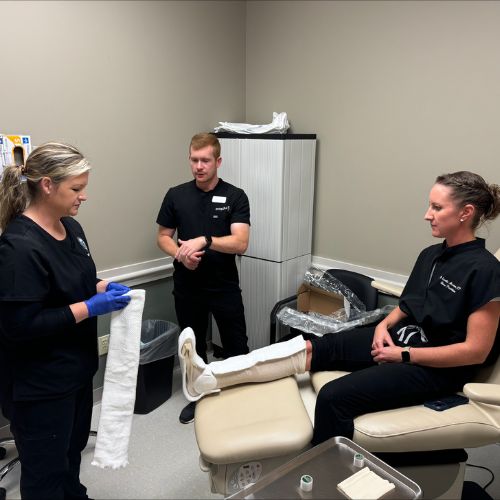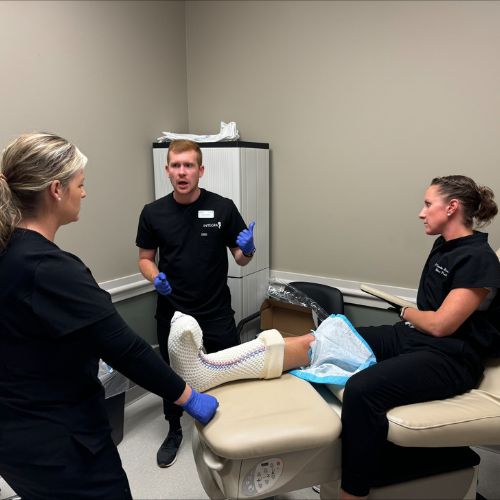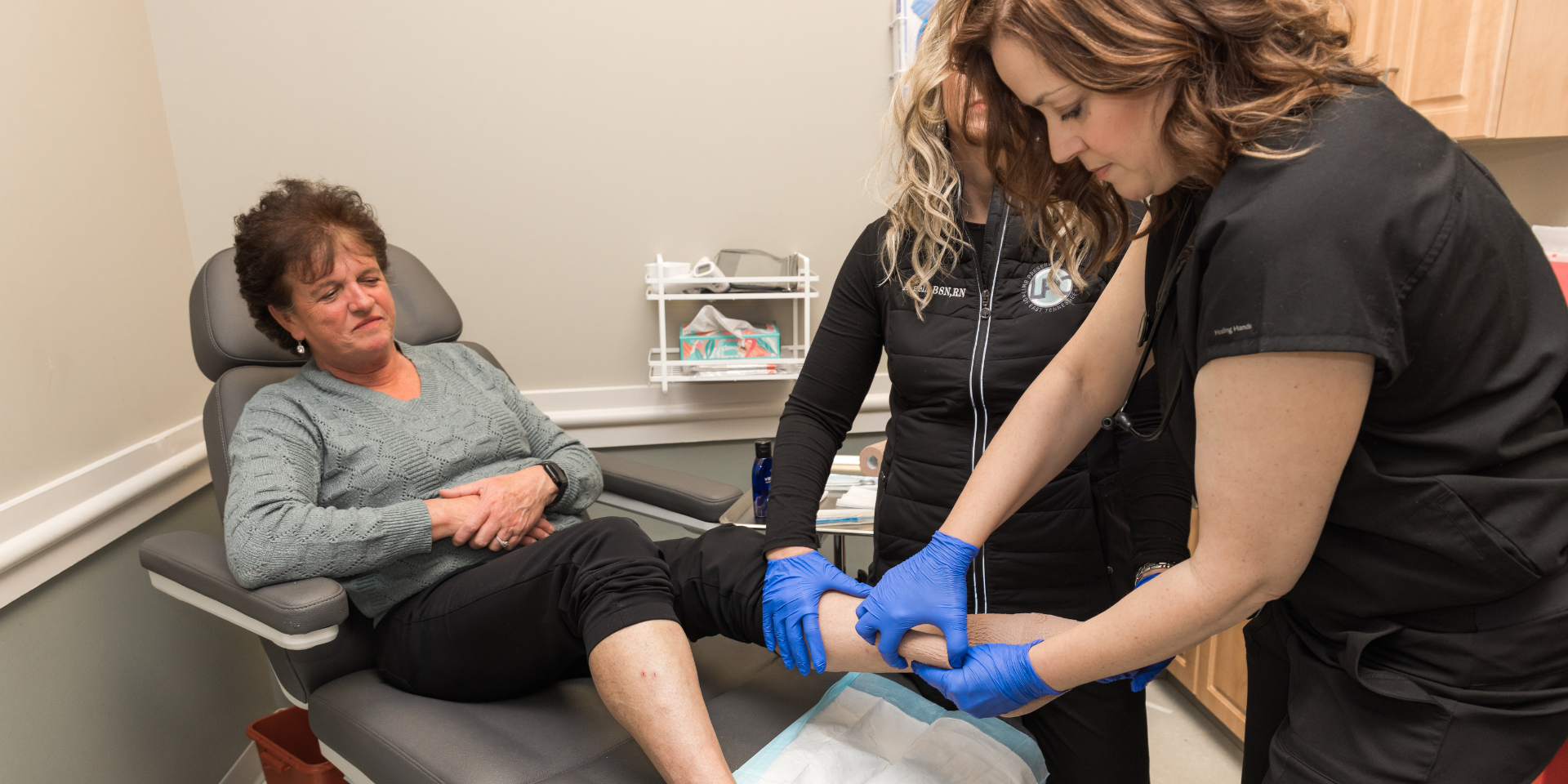Total contact casting is a crucial intervention for healing wounds in the foot. These casts effectively address issues by offloading pressure from the affected area. This redistribution of pressure across the foot promotes faster and more effective healing.
A total contact cast is a specialized device for treating diabetic foot ulcers, designed to redistribute pressure and promote healing. The application process involves precise layering and can be simplified with certain systems. These casts can be very effective, so it’s important to talk to your wound care provider to see if you’re a good fit.
What is a Total Contact Cast?
A total contact cast (TCC) is a specialized medical device used primarily for treating diabetic foot ulcers and other lower extremity wounds. It consists of a close-fitting fiberglass or plaster shell with minimal padding that encases the foot and lower leg.
The TCC’s primary function is to redistribute pressure across the entire plantar surface of the foot, effectively offloading pressure from ulcers and bony prominences. This redistribution helps protect wounds from further trauma and promotes healing.
The TCC’s unique design features multiple layers. The inner layers support a moist healing environment, while the tough outer fiberglass layer provides protection and pressure relief.
A distinctive feature of the TCC is its rocker-shaped sole, which facilitates safer walking by decreasing pressure and making movement easier. This design allows you to remain mobile during the healing process while ensuring the affected area receives minimal stress.
The Total Contact Cast Application Process

The total contact cast application process is a precise procedure that requires skill and attention to detail. It typically begins with you lying prone or supine, with the ankle at a 90-degree angle.
First, a thin dressing is applied over the ulcer. This is followed by a layer of stockinette—a soft and stretchy fabric. Protective padding is then placed between the toes and around bony prominences.
Next, a thin layer of cast padding is applied to the leg and foot. Fiberglass casting tape is then carefully wrapped around the foot and leg, ensuring total contact with the entire surface. It’s crucial to smooth out any wrinkles to prevent pressure points.
Some TCC systems, like the EZ Total Contact Cast System, simplify the process with a pre-packaged kit and a quick three-step application:
- Prep
- Roll
- Apply
This can significantly reduce application time compared to traditional TCCs, which is why the team at Limb Preservation Center has been trained in this method.
Benefits of Total Contact Casting in Wound Healing
Total contact casting offers several significant benefits in wound healing, particularly for diabetic foot ulcers, making it a crucial tool in advanced wound care. Key benefits include:
- Accelerated healing rates
- High success rates
- Prevention of complications
- Additional applications
TCC has been shown to significantly accelerate healing rates. Wounds treated with TCC heal faster compared to other methods, with average healing times of approximately six weeks. This is in contrast to months or years with conventional treatments.
This type of cast also demonstrates remarkably high success rates with the majority of diabetic foot ulcers healing effectively when treated with this method. This makes it one of the most reliable interventions for chronic wounds.
TCC supports the prevention of complications by redistributing pressure and protecting the wound. This reduces the risk of infection and lowers the likelihood of amputation in diabetic patients. Additionally, it allows you to maintain mobility while promoting effective healing, preventing further complications from immobility or improper wound care.
When TCC Isn’t the Best Option

There are instances where total contact casting is not the best option in several scenarios. This includes the presence of:
- Infected wounds
- Excessively draining ulcers
- Patients with fragile skin
This is due to their need for frequent monitoring and care. Similarly, patients with poor skin quality or severe arterial insufficiency are not candidates for TCC.
Fortunately, other options are available. Here at Limb Preservation Center of East Tennessee, we take a comprehensive, multidisciplinary approach to wound care that involves a variety of treatment options. This includes hyperbaric oxygen therapy and wound debridement for patients who aren’t a good fit for TCC.
Choose Limb Preservation Center of East Tennessee for Your Total Contact Casting
Limb Preservation Center of East Tennessee is the best choice for total contact casting in Lenoir City and the surrounding areas. Dr. Heather Hutchings and our team bring unparalleled expertise in advanced wound care techniques, ensuring precise and effective treatment.
By focusing on preventing amputations and helping patients fully heal from chronic wounds, we offer personalized care that goes beyond standard medical approaches. Our commitment to cutting-edge technology and comprehensive treatment plans means you receive top-tier casting services.

Total contact casting is an advanced wound care technique for diabetic foot ulcers, strategically designed to offload pressure and accelerate healing. Though highly effective, this precise treatment requires careful patient selection. Fortunately, our team specializes in TCC fittings. Remember that it may not be an option for wounds with infection or compromised skin integrity.
Limb Preservation Center of East Tennessee is the newest and most advanced wound care practice in Lenoir City, Tennessee. Are you looking for experienced wound care that’s convenient and near home? Call Limb Preservation Center of East Tennessee at 865-770-5462 or request an appointment online to arrange a comprehensive chronic wound evaluation with our wound healing experts.






